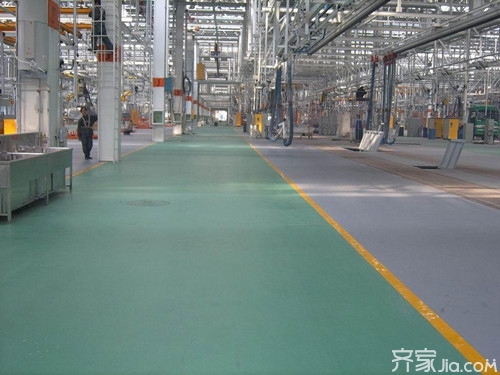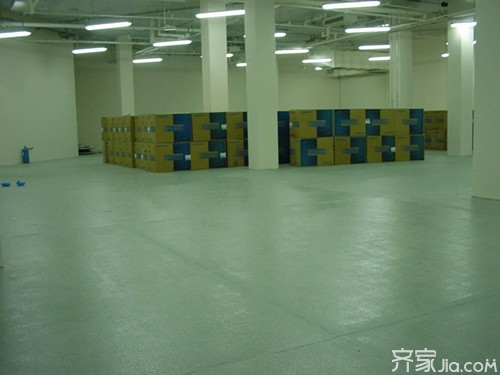In recent years, China’s vigorous development of infrastructure has begun to use this hardwearing and hardened floor in many public places. This wear-resistant and hardened floor is low in cost and durable, and the key is very beautiful. Being used in large amounts, today, we will give you the construction steps of a hardened and hardened floor.
First, the construction steps
1ã€Smoothing loft
According to the building structure reference ink line (such as wall + 50cm line), the water leveling instrument is used to set the concrete precasting thickness in the floor pouring area, set the horizontal elevation mark, and review it carefully to control the maximum concave-convex deviation within 3-5mm.

2, concrete pouring
(1) Sprinkle the concrete before placing the concrete in a wet state. In order to reduce the bleeding, the water-cement ratio and slump should be controlled. The commercial concrete should use the chute with manual discharge and should not be pumped.
(2) The concrete shall be poured as far as possible to the elevation, and where the concrete is not at the elevation, the concrete shall be used to make up and vibrate. Concrete mortar repair is strictly prohibited. Use a flat-plate vibrator to vibrate, and use a special steel drum to repeatedly roll, and columns, corners, etc., are wiped with wood. After the concrete is leveled, the cement slurry surface is at least 3mm thick.
(3) After the concrete is poured, use rubber pipe or vacuum equipment to remove the bleeding water, and then start the wear-resistant material construction twice or more. Before the construction of wear-resistant materials, the construction workers should wear flat-bottomed rubber shoes during the mid-term operation stage, and wear waterproof paper shoes to enter the post-operation stage.
3, the first time to spread the wear-resistant material and smooth, light
(1) The timing of spreading the wear-resistant material varies depending on factors such as weather, temperature, and concrete mix ratio. Spreading prematurely will cause the wear-resistant material to sink into the concrete and lose its effect; spreading the concrete too late will cause the cohesive force to be lost, and the wear-resistant material cannot be combined with it to cause peeling. The method of discriminating the spreading time of the wear-resistant material is to step on it, and when it sinks by about 5mm, the first spreading operation can be started.
(2) Walls, columns, doors, and stencils are quickly disappearing at the edge. Water should be preferentially sprinkled to prevent loss of water.
(3) The first spraying amount is 2/3 of the total amount, and the mixture should be evenly dropped. It cannot be thrown by force, and it is wiped out with a wooden trowel. After the wear-resistant material absorbs a certain amount of moisture, it is then ground and dispersed with a trowel and combined with the base concrete slurry.
4, the second sprinkle of wear-resistant materials and smooth, light
(1) For the second time, use a ruler or a straight stick to measure the level and adjust the first spread. The second spread should be perpendicular to the first.
(2) The second spread is 1/3 of the total amount. Immediately after spreading, smooth, light, and repeat the calender operation at least twice. The operation of the calenders should be staggered vertically and horizontally to ensure that the materials are concentrated. The corners are treated with wooden trowels.
(3) When the surface layer material is hardened to the point where the finger pressure is slightly depressed, the rotation speed and angle of the calender should be adjusted depending on the hardening condition. The calender should be criss-crossed more than 3 times.
(4) The flatness requirement of the wear-resistant floor is 3-5mm with the maximum deviation of 2m square, and the maximum deviation with the extreme high point and extreme low point is not more than 20mm. Try to avoid cracking, peeling or sanding

5, surface modification and maintenance
(1) There are still messy moires on the back layer of the calendering machine. To eliminate moxa, the thin layer steel trowel is used to finish the finishing process in an orderly and same way.
(2) After 5-6 hours of wear-resistant floor construction, curing agent was sprayed and cured, and the dosage was 0.2 l/m2. Or cover the plastic film to prevent cracking.
(3) After the construction of the wear-resistant floor surface is completed, the mold can be removed after 24 hours, but care should be taken not to damage the edge of the floor.
(4) After the completion of 5-7d, it is advisable to make cutting joints to prevent irregular cracks. The cutting gap should be 6-8m (usually determined according to the distance of the workshop column). Cutting should be uniform, to ensure that the cutting line is neat and straight, the cutting depth should be at least 1/5 of the floor thickness (it is recommended that the cutting joint be completed by civil works), and the filling material is made of pre-formed or cut elastic resin, etc. Use sealant.
Second, construction precautions
Preparation before construction must be done well;
Material must be spread evenly in accordance with the prescribed proportions in stages;
After the corners are treated by hand trowels, no obvious trowel marks can be found;
The finished area must not have mechanical knife marks;
Must deal with the block and block joints, can not have bad points;
The curing agent must be spread evenly and the wax tray wrung out without leaving any residue.
The knowledge about wear-resistant and hardened floor construction is introduced here and I hope to be helpful to everyone. If you want to know more related information, you can pay attention to this website information.
Stylish rugs Modern luxury kitchen Modern home improvement bar Modern desk Modern Tatami
KN95 Face Mask,Disposable KN95 Masks,95% Filtration Mask,KN95 Civil Mask
Ningbo Jiashang textile co., LTD., , https://www.cn-jshang.com